-
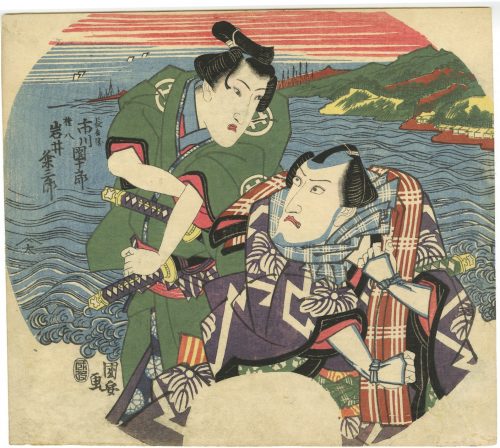 Artist: Utagawa Kuniyasu [歌川 国安] (Japanese, 1794–1832). Publisher seal: [太] (Ta): Marks 02-050 | U421b: An unknown publisher in Edo, fl. c. 1815-61; name assigned according to seal shape “Yama-Ta“. Signed: Kuniyasu ga [国安 画]. Date-aratame seal: Bunsei 9 (1826). Actors: Iwai Hanshirō VI [岩井半四郎] (Japanese, 1799 – 1836), other names: Iwai Hanshirō VI, Iwai Kumesaburō II, Iwai Hisajirō I, Baiga (poetry name), Shūka (poetry name) — as Shirai Gonpachi [白井權八]. Ichikawa Danjūrō VII 市川団十郎 (Japanese, 1791 – 1859), other names: Ichikawa Ebizō V, Ichikawa Hakuen II, Ichikawa Shinnosuke I — as Banzui Chōbei [幡随長兵衛]. Kabuki play: Suzugamori [Suzu-ga-Mori, 鈴ヶ森], a.k.a. Ukiyozuka Hiyoku no Inazuma written by Tsuruya Nanboku IV (Japanese, c. 1755 – 1829). First staged in 1823 at Ichimura-za [市村座] in Edo. Plot: "A gang of evil palanquin bearers are stationed near the Suzugamori execution grounds, where they lay in wait to rob travellers passing through. Gonpachi, who killed a man in his home province, is being sought by the police. He is fleeing to Edo when the bearers attack him in hopes of claiming a reward. He beats them off with great skill. Banzui Chōbei, who is being carried by in a palanquin, sees the attack, admires Gonpachi's ability, and promises to aid him if he is going to Edo". [Samuel L. Leiter. Historical Dictionary of Japanese Traditional Theatre. — Rowman & Littlefield, 2014; p. 382-3.; LIB-2110.2019]. Ref.: Sotheby's.
Artist: Utagawa Kuniyasu [歌川 国安] (Japanese, 1794–1832). Publisher seal: [太] (Ta): Marks 02-050 | U421b: An unknown publisher in Edo, fl. c. 1815-61; name assigned according to seal shape “Yama-Ta“. Signed: Kuniyasu ga [国安 画]. Date-aratame seal: Bunsei 9 (1826). Actors: Iwai Hanshirō VI [岩井半四郎] (Japanese, 1799 – 1836), other names: Iwai Hanshirō VI, Iwai Kumesaburō II, Iwai Hisajirō I, Baiga (poetry name), Shūka (poetry name) — as Shirai Gonpachi [白井權八]. Ichikawa Danjūrō VII 市川団十郎 (Japanese, 1791 – 1859), other names: Ichikawa Ebizō V, Ichikawa Hakuen II, Ichikawa Shinnosuke I — as Banzui Chōbei [幡随長兵衛]. Kabuki play: Suzugamori [Suzu-ga-Mori, 鈴ヶ森], a.k.a. Ukiyozuka Hiyoku no Inazuma written by Tsuruya Nanboku IV (Japanese, c. 1755 – 1829). First staged in 1823 at Ichimura-za [市村座] in Edo. Plot: "A gang of evil palanquin bearers are stationed near the Suzugamori execution grounds, where they lay in wait to rob travellers passing through. Gonpachi, who killed a man in his home province, is being sought by the police. He is fleeing to Edo when the bearers attack him in hopes of claiming a reward. He beats them off with great skill. Banzui Chōbei, who is being carried by in a palanquin, sees the attack, admires Gonpachi's ability, and promises to aid him if he is going to Edo". [Samuel L. Leiter. Historical Dictionary of Japanese Traditional Theatre. — Rowman & Littlefield, 2014; p. 382-3.; LIB-2110.2019]. Ref.: Sotheby's. -
 Artist: Utagawa Kunisada [歌川 国貞] a.k.a. Utagawa Toyokuni III [三代歌川豊国] (Japanese, 1786 – 1865). Signed: Kōchō(rō) Kunisada ga (香蝶国貞画) in a red double-gourd cartouche. Publisher: Surugaya Sakujirō [駿河屋作次郎] (Japanese, fl. c. 1844 – 1865); Marks 06-005 | 501a. Single nanushi censor seal: Muramatsu (1843-6). The date is attributed to c. 1844. Title: Narihira [なり平]. Ariwara no Narihira [在原 業平] (Japanese, 825 – 880) – one of the Six Immortal Poets – The Rokkasen [六歌仙]. Series: A parody of six immortal poets [見立六花撰] (Mitate Rokkasen). Media: Untrimmed fan print (uchiwa-e), 227 x 293 mm, depicting a beautiful woman with a bow and arrows in her left hand. Series: Mitate Rokkasen [見立六花撰] – is sometimes interpreted as "A parody of six immortal poets" or "A comparison of six select flowers". [LIB-1212.2017] Robert Schaap. Kunisada: Imaging, drama and beauty. — Leiden: Hotei Publishing, 2016; pl. 28, p. 58. This is another fan print with another immortal poet, Bun'ya no Yasuhide [文屋 康秀] (Japanese, -d. 885?), from the same series, provided in the book:With special thanks to Horst Graebner for help with the description and date attribution: "The print can be dated to 1844: censor seal is Muramatsu (Muramatsu Genroku); he acted in 7/1844 and 4/1845 (and also later) as censor but Kunisada changed his name to Kunisada early in 1844."
Artist: Utagawa Kunisada [歌川 国貞] a.k.a. Utagawa Toyokuni III [三代歌川豊国] (Japanese, 1786 – 1865). Signed: Kōchō(rō) Kunisada ga (香蝶国貞画) in a red double-gourd cartouche. Publisher: Surugaya Sakujirō [駿河屋作次郎] (Japanese, fl. c. 1844 – 1865); Marks 06-005 | 501a. Single nanushi censor seal: Muramatsu (1843-6). The date is attributed to c. 1844. Title: Narihira [なり平]. Ariwara no Narihira [在原 業平] (Japanese, 825 – 880) – one of the Six Immortal Poets – The Rokkasen [六歌仙]. Series: A parody of six immortal poets [見立六花撰] (Mitate Rokkasen). Media: Untrimmed fan print (uchiwa-e), 227 x 293 mm, depicting a beautiful woman with a bow and arrows in her left hand. Series: Mitate Rokkasen [見立六花撰] – is sometimes interpreted as "A parody of six immortal poets" or "A comparison of six select flowers". [LIB-1212.2017] Robert Schaap. Kunisada: Imaging, drama and beauty. — Leiden: Hotei Publishing, 2016; pl. 28, p. 58. This is another fan print with another immortal poet, Bun'ya no Yasuhide [文屋 康秀] (Japanese, -d. 885?), from the same series, provided in the book:With special thanks to Horst Graebner for help with the description and date attribution: "The print can be dated to 1844: censor seal is Muramatsu (Muramatsu Genroku); he acted in 7/1844 and 4/1845 (and also later) as censor but Kunisada changed his name to Kunisada early in 1844."
Robert Schaap, 2016.
-
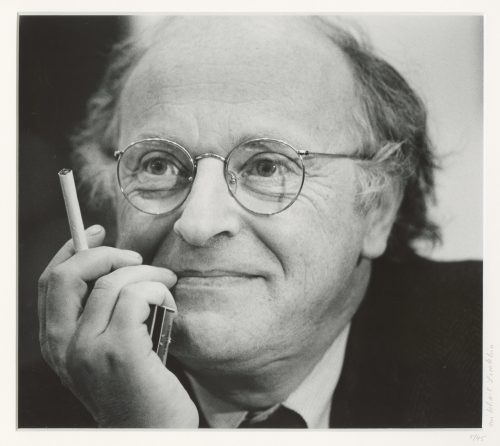 Photographic portrait of poet Joseph Brodsky, head, hand, and shoulder, three-quarters to the left, wearing glasses and with a cigarette. Pencil-signed on the mat: 5/45 • Mikhail Lemkhin; same inscription on the back of the print, and ink stamp ©Mikhail Lemkhin. Sitter: Joseph Brodsky [Иосиф Александрович Бродский ] (Russian-American-Jewish, 1940 – 1996). Size: mat: 41 x 51 cm; window: 27 x 30 cm; print: 27.7 x 35.4 cm.
Photographic portrait of poet Joseph Brodsky, head, hand, and shoulder, three-quarters to the left, wearing glasses and with a cigarette. Pencil-signed on the mat: 5/45 • Mikhail Lemkhin; same inscription on the back of the print, and ink stamp ©Mikhail Lemkhin. Sitter: Joseph Brodsky [Иосиф Александрович Бродский ] (Russian-American-Jewish, 1940 – 1996). Size: mat: 41 x 51 cm; window: 27 x 30 cm; print: 27.7 x 35.4 cm. -
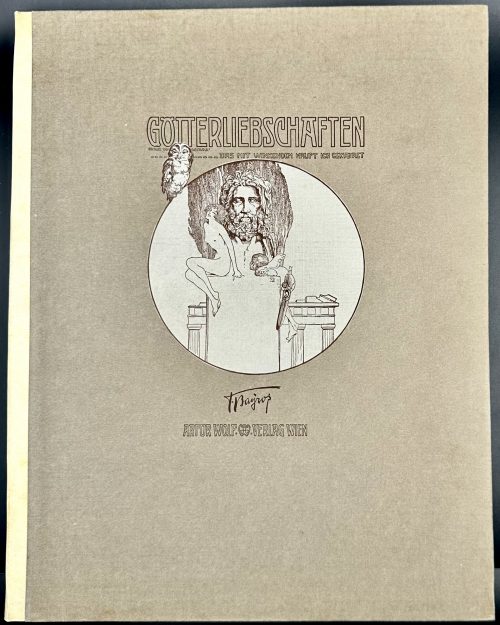 Letterpress title-page, engraved title-page, and 10 sheets of collotype plates printed on india paper mounted on thick wove paper, with captioned guard sheets, loose in a vellum-backed cardboard portfolio with cloth-mounted flaps; floral diaper design inside throughout; bookseller's label to front board verso; limited edition of 550 copies of which this is copy № 103. Dimensions: 338 x 268 mm portfolio; 325 x 260 mm sheet, 225 x 195 mm image. Front board with lettering and vignette: GÖTTERLIEBSCHAFTEN | DAS MIT WINKENDEM HAUPT ICH GEWAHRET | {vignette} | {signature} | ARTUR WOLF / VERLAG WIEN || Letterpress title-page: FRANZ VON BAYROS | “GÖTTERLIEBSCHAFTEN” | ARTUR WOLF / VERLAG WIEN | 1914 || Verso to letterpress t.p. VERZEICHNIS DER TAFELN.
Letterpress title-page, engraved title-page, and 10 sheets of collotype plates printed on india paper mounted on thick wove paper, with captioned guard sheets, loose in a vellum-backed cardboard portfolio with cloth-mounted flaps; floral diaper design inside throughout; bookseller's label to front board verso; limited edition of 550 copies of which this is copy № 103. Dimensions: 338 x 268 mm portfolio; 325 x 260 mm sheet, 225 x 195 mm image. Front board with lettering and vignette: GÖTTERLIEBSCHAFTEN | DAS MIT WINKENDEM HAUPT ICH GEWAHRET | {vignette} | {signature} | ARTUR WOLF / VERLAG WIEN || Letterpress title-page: FRANZ VON BAYROS | “GÖTTERLIEBSCHAFTEN” | ARTUR WOLF / VERLAG WIEN | 1914 || Verso to letterpress t.p. VERZEICHNIS DER TAFELN.- Europa und der Stier
- Leda und die Schildkröte
- Sterope und Herkules
- Herodikos und die Turnerinnen
- Phoroneus und die Hirtin
- Minos und Persipeia
- Phryne und Mutter
- Pytalos und Demeter
- Kirke und die Ferkel
- Putiphar
-
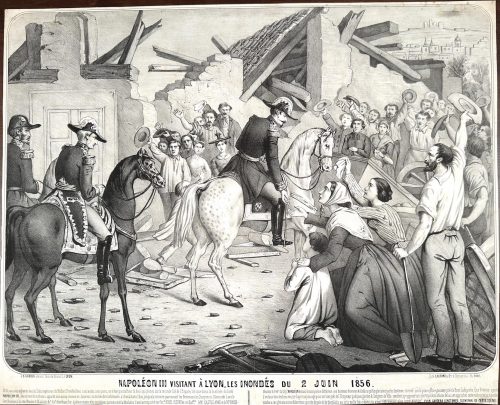 Lithography poster on wove paper, 492 x 614 mm; black ink stamp “5036” to reverse, vertical centerfold. Image in frame; under the frame left: "J. B. Gadola, éditeur. Cours de Brosses 1, à LYON."; right: "Lith LAURANT & Cie r. de Bernardins 34, Paris." Title and text below the image. Jean-Baptiste Gadola (French, 1818 – 1870) – publisher.
Lithography poster on wove paper, 492 x 614 mm; black ink stamp “5036” to reverse, vertical centerfold. Image in frame; under the frame left: "J. B. Gadola, éditeur. Cours de Brosses 1, à LYON."; right: "Lith LAURANT & Cie r. de Bernardins 34, Paris." Title and text below the image. Jean-Baptiste Gadola (French, 1818 – 1870) – publisher. -
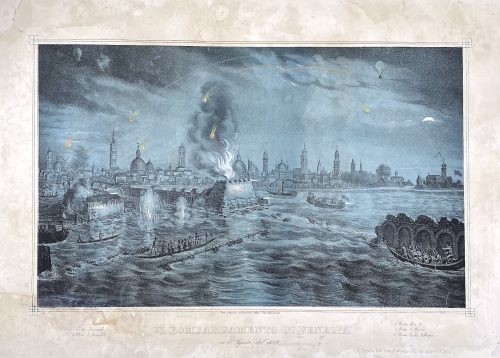 Quaritch's description: Single sheet (435 x 625 mm); coloured lithograph by Kirchmayr after a drawing by M. Fontana; hand-painted details; signed to lower left ‘M. Fon[tana]’ and to lower right ‘M. Fontana Edit. Prop. S. Giacomo dall’Orio in Isola N°.1481’; lower margin with the title ‘Il bombardamento di Venezia nell’Agosto 1849’ and key; restored tears in many places, especially along upper and lower blank margins, some affecting print; losses to lower left corner, affecting a small portion of the print, ruled border, and key, restored and re-drawn where needed; loss to the upper left corner of blank margin; two small areas of restoration to the centre of upper blank margin; the whole sheet backed; nevertheless a remarkable survival. Exceedingly rare and striking lithograph of Venice as seen from Fusina, depicting the first ever aerial bombardment in history. The bombardment took place in 1849, under the orders of Field Marshal Josef Radetzky (1766–1858), to quell the revolts that had started the previous year during the First Italian War of Independence. This curious and little-known action was the brainchild of Colonel Benno Uchatius, a brilliant young officer in the Austro-Hungarian Artillery. After long months of unsuccessful siege, Uchatius decided to deploy an unusual weapon: a hot air balloon able to bomb the city from above. Having calculated the wind speed and direction and evaluated the requisite dimensions of the hot-air balloon, Uchatius set up a workshop near Mestre, where a group of engineers and craftsmen began to manufacture a balloon equipped with a large wicker basket which could transport two crewmen and approximately one hundred kilograms of small long-fuse devices (metal spheres filled with gunpowder, pitch, oil and five hundred rifle buckshot). The initial trials, however, proved to be a disaster, because the balloon would drift off course, making it impossible to accurately deploy the bombs. Uchatius then hit upon the idea of using several smaller unmanned balloons roped together. These were to be launched over the city and, using the position of the first ‘pilot’ balloon, which was unarmed, the Austrians could calculate the correct fuse settings for the bombs. The ‘bomber’ balloons had a cloth envelope of one hundred cubic metres and a reduced load of about twenty kilograms of ordnance. According to Uchatius’ calculations, the line of balloons, launched from Mestre, would reach the lagoon city in thirty-five to forty minutes, carried by the north-west wind. In July 1849, a first launch was attempted, but when a breeze began to blow from the sea some of the balloons broke the connecting ropes and floated away, while others settled in the water in front of the northern part of the city, where a curious crowd of Venetians observed the failure of the enterprise and commented colourfully on the ‘buffoonery of Radetzky’. Uchatius’ second attempt, which is depicted in this lithograph, was also largely unsuccessful: only a few of the unmanned bomber balloons reached their target, and some even drifted back over the Austrian lines. Uchatius, having accomplished the first ever aerial bombardment, and having designed the first ever military ‘drones’, was forced to abandon the project permanently. Another fascinating aspect of this work is the vantage point used to depict the city of Venice, seen here from Fusina, a very rare viewpoint that makes this piece even more remarkable. We were unable to locate any copies in any institution or bibliography. G. Kirchmayr (fl. mid-19th century) is mentioned at British Museum database as "Lithographer active in Venice; related to Venetian painter Cherubino Kirchmayr (b. 1848)?" However, I was not able to find that name on the print. Not much is known of M. Fontana either.
Quaritch's description: Single sheet (435 x 625 mm); coloured lithograph by Kirchmayr after a drawing by M. Fontana; hand-painted details; signed to lower left ‘M. Fon[tana]’ and to lower right ‘M. Fontana Edit. Prop. S. Giacomo dall’Orio in Isola N°.1481’; lower margin with the title ‘Il bombardamento di Venezia nell’Agosto 1849’ and key; restored tears in many places, especially along upper and lower blank margins, some affecting print; losses to lower left corner, affecting a small portion of the print, ruled border, and key, restored and re-drawn where needed; loss to the upper left corner of blank margin; two small areas of restoration to the centre of upper blank margin; the whole sheet backed; nevertheless a remarkable survival. Exceedingly rare and striking lithograph of Venice as seen from Fusina, depicting the first ever aerial bombardment in history. The bombardment took place in 1849, under the orders of Field Marshal Josef Radetzky (1766–1858), to quell the revolts that had started the previous year during the First Italian War of Independence. This curious and little-known action was the brainchild of Colonel Benno Uchatius, a brilliant young officer in the Austro-Hungarian Artillery. After long months of unsuccessful siege, Uchatius decided to deploy an unusual weapon: a hot air balloon able to bomb the city from above. Having calculated the wind speed and direction and evaluated the requisite dimensions of the hot-air balloon, Uchatius set up a workshop near Mestre, where a group of engineers and craftsmen began to manufacture a balloon equipped with a large wicker basket which could transport two crewmen and approximately one hundred kilograms of small long-fuse devices (metal spheres filled with gunpowder, pitch, oil and five hundred rifle buckshot). The initial trials, however, proved to be a disaster, because the balloon would drift off course, making it impossible to accurately deploy the bombs. Uchatius then hit upon the idea of using several smaller unmanned balloons roped together. These were to be launched over the city and, using the position of the first ‘pilot’ balloon, which was unarmed, the Austrians could calculate the correct fuse settings for the bombs. The ‘bomber’ balloons had a cloth envelope of one hundred cubic metres and a reduced load of about twenty kilograms of ordnance. According to Uchatius’ calculations, the line of balloons, launched from Mestre, would reach the lagoon city in thirty-five to forty minutes, carried by the north-west wind. In July 1849, a first launch was attempted, but when a breeze began to blow from the sea some of the balloons broke the connecting ropes and floated away, while others settled in the water in front of the northern part of the city, where a curious crowd of Venetians observed the failure of the enterprise and commented colourfully on the ‘buffoonery of Radetzky’. Uchatius’ second attempt, which is depicted in this lithograph, was also largely unsuccessful: only a few of the unmanned bomber balloons reached their target, and some even drifted back over the Austrian lines. Uchatius, having accomplished the first ever aerial bombardment, and having designed the first ever military ‘drones’, was forced to abandon the project permanently. Another fascinating aspect of this work is the vantage point used to depict the city of Venice, seen here from Fusina, a very rare viewpoint that makes this piece even more remarkable. We were unable to locate any copies in any institution or bibliography. G. Kirchmayr (fl. mid-19th century) is mentioned at British Museum database as "Lithographer active in Venice; related to Venetian painter Cherubino Kirchmayr (b. 1848)?" However, I was not able to find that name on the print. Not much is known of M. Fontana either. -
 Artist: Torii Kiyonaga [鳥居 清長] (Japanese, 1752 – 1815) Color woodblock print: makimono-e (11.4 x 65.4 cm). Year: c. 1785. Three sheets of the series of twelve, № 6, № 9, and № 11, "from Kiyonaga's most idiosyncratic and celebrated series of pornography. It was designed as part of a miniature handscroll (makimono) to place in one's sleeve, where it was carried both for its stimulatory and for its talismanic properties." [LIB-1474.2018] Important Japanese prints from the collection of Henry Steiner by Sebastian Izzard.]№ 6: "The woman's blackened teeth indicate that she is a wife. This middle-aged couple is relaxing and drowsing after lovemaking. The scene is peaceful now., but the pillow cast aside hints at their earlier, passionate lovemaking".
Artist: Torii Kiyonaga [鳥居 清長] (Japanese, 1752 – 1815) Color woodblock print: makimono-e (11.4 x 65.4 cm). Year: c. 1785. Three sheets of the series of twelve, № 6, № 9, and № 11, "from Kiyonaga's most idiosyncratic and celebrated series of pornography. It was designed as part of a miniature handscroll (makimono) to place in one's sleeve, where it was carried both for its stimulatory and for its talismanic properties." [LIB-1474.2018] Important Japanese prints from the collection of Henry Steiner by Sebastian Izzard.]№ 6: "The woman's blackened teeth indicate that she is a wife. This middle-aged couple is relaxing and drowsing after lovemaking. The scene is peaceful now., but the pillow cast aside hints at their earlier, passionate lovemaking".
Picture № 6. (31d in LIB-2971.2022)
№ 9: "This looks to be the first sexual experience of a young woman of a well-to-do family, who covers her mouth shyly. The more experienced man moistens his fingers with saliva, eager to explore the young woman's body".
Picture № 9.
№ 11: "The woman wears a so-called Iwata sash signalling that she is pregnant. The man approaches from behind so as not to put pressure on her stomach. He shows care and gentle consideration toward his pregnant wife, who appears relaxed". Picture descriptions from Shunga: Sex and Pleasure in Japanese art. Edited by Timothy Clark, C. Andrew Gerstle, Aki Ishigami, Akiki Yano. Hotei Publishing, 2013. Ref.: [LIB-2971.2022] Chris Uhlenbeck, Margarita Winkel. Japanese erotic fantasies sexual imagery of the Edo period. — Amsterdam: Hotei Publishing, ©2005; p. 118-9 (№ 31).
Picture № 11. (31g in LIB-2971.2022)
-
 Katsukawa Shunshō ( 勝川 春章; 1726 – 19 January 1793).
Katsukawa Shunshō ( 勝川 春章; 1726 – 19 January 1793).Signed: Shunchô ga (春潮画); Censor's seal: kiwame (改印:極)
Publisher: Iwatoya Kisaburō (Eirindō); c. 1760s – 1832. Marks #173/p.169.
Reference: MFA ACCESSION NUMBER 11.21263. Not in Pins.
Act VII, Gion Ichiriki no ba ("The Ichiriki Teahouse at Gion") This act gives a taste of the bustling atmosphere of the Gion pleasure quarter in Kyoto. Yuranosuke is feigning a life of debauchery at the same teahouse to which Okaru has been indentured. Kudayū, the father of Sadakurō, arrives. He is now working for Moronō and his purpose is to discover whether Yuranosuke still plans revenge or not. He tests Yuranosuke's resolve by offering him food on the anniversary of their lord's death when he should be fasting. Yuranosuke is forced to accept. Yuranosuke's sword – the revered symbol of a samurai – is also found to be covered in rust. It would appear that Yuranosuke has no thoughts of revenge. But still unsure, Kudayū hides under the veranda. Now believing himself alone, Yuranosuke begins to read a secret letter scroll about preparations for the vendetta. On a higher balcony Okaru comes out to cool herself in the evening breeze and, noticing Yuranosuke close by, she also reads the letter reflected in her mirror. As Yuranosuke unrolls the scroll, Kudayū, too, examines the end which trails below the veranda. Suddenly, one of Okaru's hairpins drops to the floor and a shocked Yuranosuke quickly rolls up the scroll. Finding the end of the letter torn off, he realises that yet another person knows his secret and he must silence them both. Feigning merriment, he calls Okaru to come down and offers to buy out her contract. He goes off supposedly to fix the deal. Then Okaru's brother Heiemon enters and, hearing what has just happened, realises that Yuranosuke actually intends to keep her quiet by killing her. He persuades Okaru to let him kill her instead so as to save their honour and she agrees. Overhearing everything, Yuranosuke is now convinced of the pair's loyalty and stops them. He gives Okaru a sword and, guiding her hand, thrusts it through the floorboards to kill Kudayū. The main actor has to convey a wide variety of emotions between a fallen, drunkard rōnin and someone who in reality is quite different since he is only faking his weakness. This is called hara-gei or "belly acting", which means he has to perform from within to change characters. It is technically difficult to perform and takes a long time to learn, but once mastered the audience takes up on the actor's emotion. Emotions are also expressed through the colours of the costumes, a key element in kabuki. Gaudy and strong colours can convey foolish or joyful emotions, whereas severe or muted colours convey seriousness and focus. -
 Artist: Utagawa Kuniyoshi [歌川 國芳] (Japanese, 1798 – 1861).
Artist: Utagawa Kuniyoshi [歌川 國芳] (Japanese, 1798 – 1861).Title: Suzume fukube [美人団扇絵] (Sparrow and gourds).
Series: Kacho awase [花鳥合] (Collection of flowers and birds).
Publisher: Aritaya Seiemon [有田屋 清右衛門] (Japanese, fl. c. 1830 – 1862); Seal: Marks 17-011 | 014d.Signed: Ichiyosai Kuniyoshi ga in a red cartouche and sealed with paulownia crest (kiri mon).
Size: Uchiwa-e (untrimmed fan print) 296 x 230 mm.
Double nanushi censor seals: Kinugasa & Watanabe, Kaei 2-3 (1849–50).
Ref.: Kuniyoshi Project. -
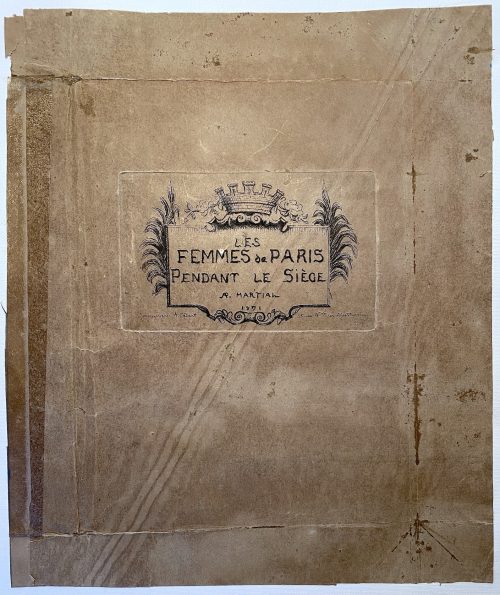 A suite of 12 etchings 160 x 118 mm each, in the first state, pasted on paper, 2 per sheet, with a cover (250 x 210 mm).0. Cover. Les femmes de Paris pendant le siège./R.Martial/1871.1. Lorsqu'à l'approche de l'ennemi on demandait l'éloignement des bouches inutiles [...] 2. L'Ennemi ! 3. No inscription 4. Quête pour les veuves. 5. Concert et quête pour les enfants blessés, malades, infirmes. 6. Au bastion/Et celles non moins précieuses qui dirigeaient ces ventes [...] 7. Vente pour les orphelins de la guerre. 8. No inscription 9. Une ration, bouillie romaine et Vin/Cantine municipale[...] 10. No inscription 11. No inscription 12. Les effets de cette union patriotique des femmes sont connus.[...]
A suite of 12 etchings 160 x 118 mm each, in the first state, pasted on paper, 2 per sheet, with a cover (250 x 210 mm).0. Cover. Les femmes de Paris pendant le siège./R.Martial/1871.1. Lorsqu'à l'approche de l'ennemi on demandait l'éloignement des bouches inutiles [...] 2. L'Ennemi ! 3. No inscription 4. Quête pour les veuves. 5. Concert et quête pour les enfants blessés, malades, infirmes. 6. Au bastion/Et celles non moins précieuses qui dirigeaient ces ventes [...] 7. Vente pour les orphelins de la guerre. 8. No inscription 9. Une ration, bouillie romaine et Vin/Cantine municipale[...] 10. No inscription 11. No inscription 12. Les effets de cette union patriotique des femmes sont connus.[...] -
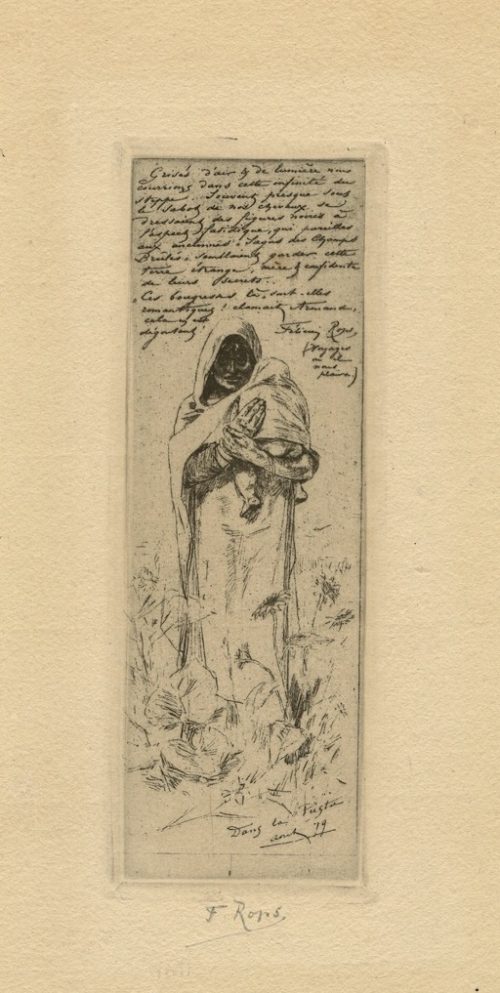
Etching and drypoint, signed in pencil by the artist under the plate; 2nd state. Pasted on a sheet of blue paper. Fragment of "La messe de Gnide". Owner's stamp 'LvM' on verso.
Dimensions: Blue paper: 32 x 27 cm; Laid paper: 30.7 x 22 cm; Image: 12.5 x 4 cm.
Catalogue raisonné: Arthur Hubschmid (1977): 364; Graphics irreverent and erotic (1968): 59; Rouir: 508.
-
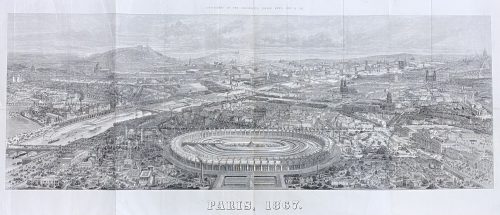
Lithography on paper by Charles Fichot (French, 1817 – 1903), published in a supplement to the Illustrated London News of July 6, 1867.
The construction on the foreground is the International Exposition of 1867 (Exposition universelle d'art et d'industrie de 1867). Dimensions: Sheet: 130 x 58 cm; Image: 118 x 43 cm. -
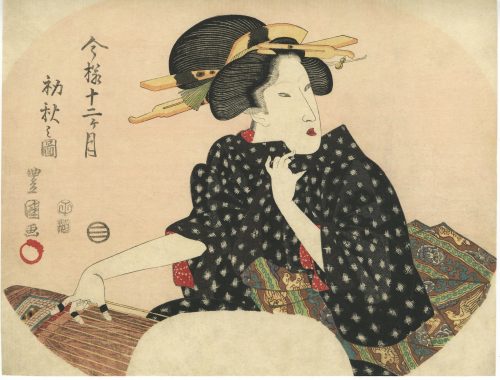 Title: Seventh lunar month [初秋] (Hatsuaki no zu); Series: Fashionable Twelve Months (Imayo juni-kagetsu). Another version of translation: Modern Beauties of Twelve Months. Artist: Utagawa Toyokuni I [歌川豊国] (1769–1825). Pubisher: Ibaya Senzaburō [伊場屋仙三郎] (Japanese, 1815 – 1869), seal: Dansendō [伊場仙]. Signed: Toyokuni ga and sealed with toshidama. Date-kiwame seal: Ushi (ox), Bunsei 5 (1822). Size: double-sheet uncut fan print ( aiban uchiwa-e), 219 x 295 mm.
Title: Seventh lunar month [初秋] (Hatsuaki no zu); Series: Fashionable Twelve Months (Imayo juni-kagetsu). Another version of translation: Modern Beauties of Twelve Months. Artist: Utagawa Toyokuni I [歌川豊国] (1769–1825). Pubisher: Ibaya Senzaburō [伊場屋仙三郎] (Japanese, 1815 – 1869), seal: Dansendō [伊場仙]. Signed: Toyokuni ga and sealed with toshidama. Date-kiwame seal: Ushi (ox), Bunsei 5 (1822). Size: double-sheet uncut fan print ( aiban uchiwa-e), 219 x 295 mm.

-
 Artist: Utagawa Kunisada [歌川 国貞] a.k.a. Utagawa Toyokuni III [三代歌川豊国] (Japanese, 1786 – 1865). Signed: Ichiyōsai Toyokuni hitsu [一陽斎豊国筆]. Inscriptions: [松竹梅] Shochikubai = pine (matsu, 松), bamboo (take, 竹), and plum (ume, 梅) – an auspicious grouping known as "The Three Friends of Winter"; [三福追] (Sanpuku tsui) – the three delights, or pleasures. Date seal and aratame censor seal: Ansei 2, 1st month (1855). Publisher: Ibaya Senzaburō [伊場屋仙三郎] (Japanese, c. 1815 – 1869). Block carver: Yokokawa Takejirō [横川竹二郎] (Japanese, fl. 1845 – 1863); seal: Hori Take [彫竹]. Kabuki actor Nakamura Shikan IV [中村芝翫] (Nakamura Fukusuke I [中村福助], Nakamura Masanosuke I, Nakamura Komasaburō, Nakamura Tamatarō I, Japanese, 1831 – 1899) arranging a branch of blossoming plum to the memorial portrait of his predecessor Nakamura Utaemon IV [中村歌右衛門] (Nakamura Shikan II, Nakamura Tsurusuke I, Nakamura Tōtarō, Japanese, 1796 – 1852); the latter is dressed in a black robe adorned with a mokkō-crest (mon) of white plum blossom, the hanging scroll border decorated with arabesque and plum blossoms. Actors identified by Horst Graebner. Two fan prints from this series in Varshavsky Collection:
Artist: Utagawa Kunisada [歌川 国貞] a.k.a. Utagawa Toyokuni III [三代歌川豊国] (Japanese, 1786 – 1865). Signed: Ichiyōsai Toyokuni hitsu [一陽斎豊国筆]. Inscriptions: [松竹梅] Shochikubai = pine (matsu, 松), bamboo (take, 竹), and plum (ume, 梅) – an auspicious grouping known as "The Three Friends of Winter"; [三福追] (Sanpuku tsui) – the three delights, or pleasures. Date seal and aratame censor seal: Ansei 2, 1st month (1855). Publisher: Ibaya Senzaburō [伊場屋仙三郎] (Japanese, c. 1815 – 1869). Block carver: Yokokawa Takejirō [横川竹二郎] (Japanese, fl. 1845 – 1863); seal: Hori Take [彫竹]. Kabuki actor Nakamura Shikan IV [中村芝翫] (Nakamura Fukusuke I [中村福助], Nakamura Masanosuke I, Nakamura Komasaburō, Nakamura Tamatarō I, Japanese, 1831 – 1899) arranging a branch of blossoming plum to the memorial portrait of his predecessor Nakamura Utaemon IV [中村歌右衛門] (Nakamura Shikan II, Nakamura Tsurusuke I, Nakamura Tōtarō, Japanese, 1796 – 1852); the latter is dressed in a black robe adorned with a mokkō-crest (mon) of white plum blossom, the hanging scroll border decorated with arabesque and plum blossoms. Actors identified by Horst Graebner. Two fan prints from this series in Varshavsky Collection:
SVJP-0336.2021
-
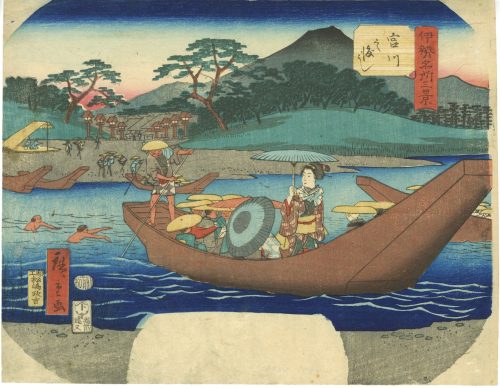 Artist: Utagawa Hiroshige II (二代目 歌川広重] (Japanese, 1826 – 1869). Signed: Hiroshige ga. Publisher: Enshūya Matabei [遠州屋又兵衛] (Japanese, fl. c. 1768 – 1881); (Enmata [遠又]), seal 22-009 (Marks). Block carver: Matsushima Masakichi (Japanese, fl. c. 1847-65); seal: [松嶋彫政] – Hori Masa (Frieze, 2009: 142). Combined date seal and kiwame censor seal: Bunkyū 2 (1862). Media: Fan print (uchiwa-e, 団扇絵), 230 x 298 mm Series: Three Famous Views in Ise [伊勢名所三景] (Ise meisho sankei).
Artist: Utagawa Hiroshige II (二代目 歌川広重] (Japanese, 1826 – 1869). Signed: Hiroshige ga. Publisher: Enshūya Matabei [遠州屋又兵衛] (Japanese, fl. c. 1768 – 1881); (Enmata [遠又]), seal 22-009 (Marks). Block carver: Matsushima Masakichi (Japanese, fl. c. 1847-65); seal: [松嶋彫政] – Hori Masa (Frieze, 2009: 142). Combined date seal and kiwame censor seal: Bunkyū 2 (1862). Media: Fan print (uchiwa-e, 団扇絵), 230 x 298 mm Series: Three Famous Views in Ise [伊勢名所三景] (Ise meisho sankei). -
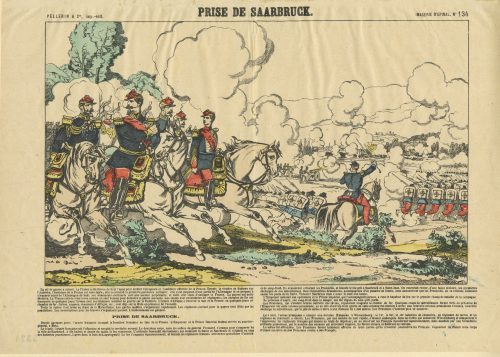 Hand-coloured woodcut on wove paper, 268 x 381 mm, vertical centerfold. On reverse: black ink stamp “5324”. Top centre: "PRISE DE SAARBRUCK"; left: "PELLERIN & Cie, imp. -édit."; right: "IMAGERIE D'EPINAL, № 134." Under the frame text starts with « La cri de guerre a retenti. La France a été forcée de tirer l’épée pour arrêter… ».[...] Prise de Saarbruck. | Depuis quelques jours, l’armée française occupait la frontière française en face de la Prusse.... Jean Charles Pellerin (French, 1756 – 1836) – publisher/printer. The Battle of Saarbrücken (2 August 1870).
Hand-coloured woodcut on wove paper, 268 x 381 mm, vertical centerfold. On reverse: black ink stamp “5324”. Top centre: "PRISE DE SAARBRUCK"; left: "PELLERIN & Cie, imp. -édit."; right: "IMAGERIE D'EPINAL, № 134." Under the frame text starts with « La cri de guerre a retenti. La France a été forcée de tirer l’épée pour arrêter… ».[...] Prise de Saarbruck. | Depuis quelques jours, l’armée française occupait la frontière française en face de la Prusse.... Jean Charles Pellerin (French, 1756 – 1836) – publisher/printer. The Battle of Saarbrücken (2 August 1870). -
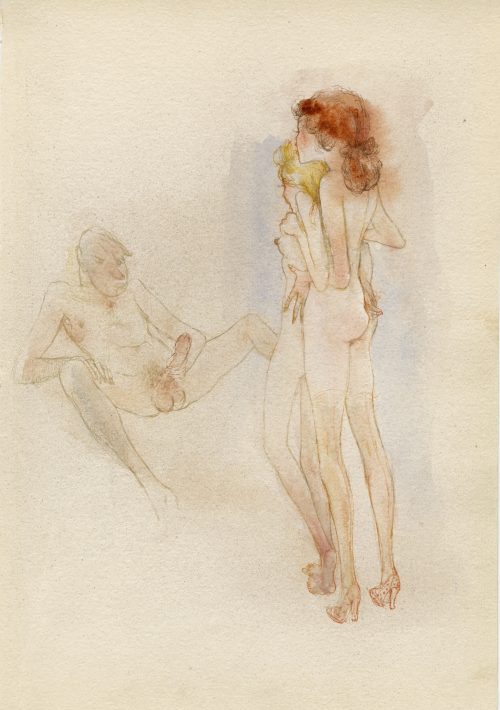 Watercolour on thick wove paper, unsigned. Attributed to Otto Rudolf Schatz (Austrian, 1900 – 1961). Size: 305 x 212 mm.
Watercolour on thick wove paper, unsigned. Attributed to Otto Rudolf Schatz (Austrian, 1900 – 1961). Size: 305 x 212 mm. -
 Artist: Utagawa Kunisada [歌川 国貞] a.k.a. Utagawa Toyokuni III [三代歌川豊国] (Japanese, 1786 – 1865). Signed: Toyokuni ga [豊国 画] in a red toshidama cartouche. Actor: Sawamura Gennosuke II [沢村源之助] (Japanese, 1802/7 – 1853); other names: Suketakaya Takasuke III, Sawamura Chōjūrō V [沢村長十郎], Sawamura Tosshō I, Sawamura Genpei I. Character: Kameya Chubei [亀屋忠兵衛] Play: Koi Bikyaku Yamato Orai [恋飛脚大和往来] Performance: Kawarasaki Theatre [河原崎座] in the 2nd month of 1851. Double nanushi censor seals: Fuku & Muramatsu, from 3rd month of Kaei 2 to 11th month of Kaei 4 (1849-51). Another fan print from the pair SVJP-0212-1.2016: Ichikawa Ebizō V as Tanbaya Onizo / Fan print, 1851.
Artist: Utagawa Kunisada [歌川 国貞] a.k.a. Utagawa Toyokuni III [三代歌川豊国] (Japanese, 1786 – 1865). Signed: Toyokuni ga [豊国 画] in a red toshidama cartouche. Actor: Sawamura Gennosuke II [沢村源之助] (Japanese, 1802/7 – 1853); other names: Suketakaya Takasuke III, Sawamura Chōjūrō V [沢村長十郎], Sawamura Tosshō I, Sawamura Genpei I. Character: Kameya Chubei [亀屋忠兵衛] Play: Koi Bikyaku Yamato Orai [恋飛脚大和往来] Performance: Kawarasaki Theatre [河原崎座] in the 2nd month of 1851. Double nanushi censor seals: Fuku & Muramatsu, from 3rd month of Kaei 2 to 11th month of Kaei 4 (1849-51). Another fan print from the pair SVJP-0212-1.2016: Ichikawa Ebizō V as Tanbaya Onizo / Fan print, 1851.



